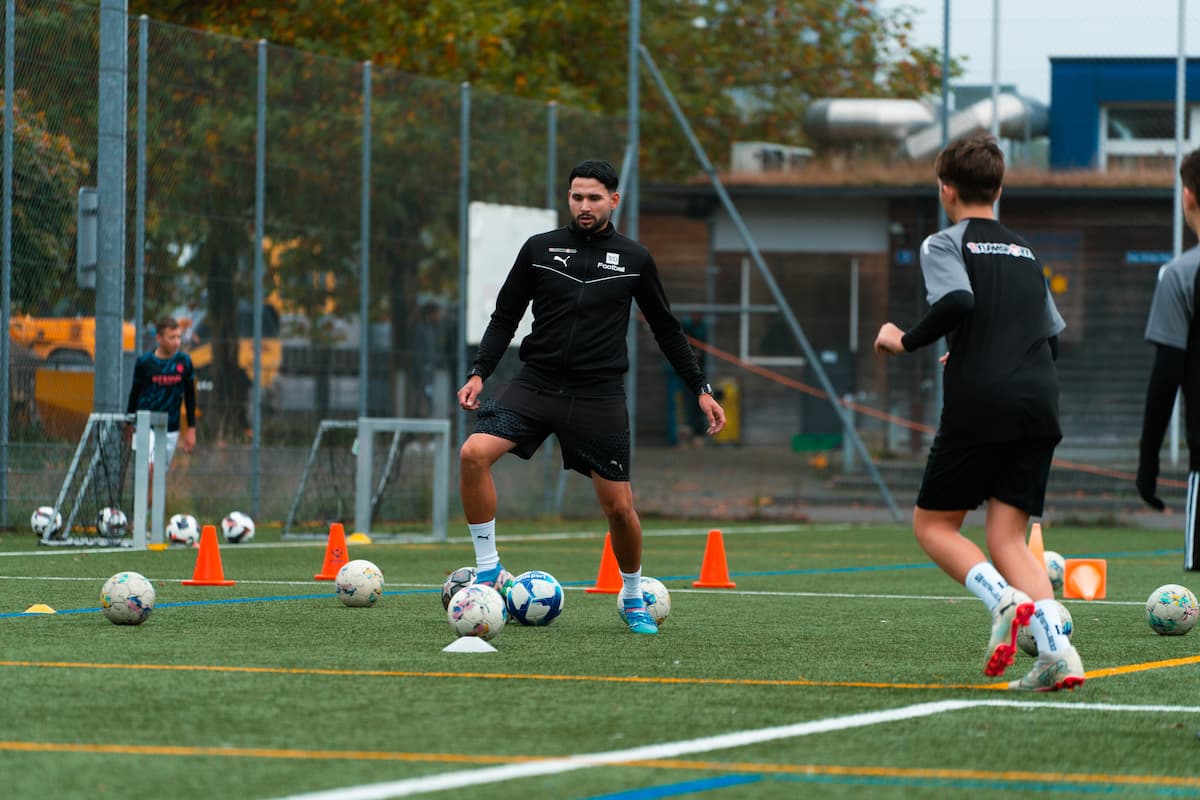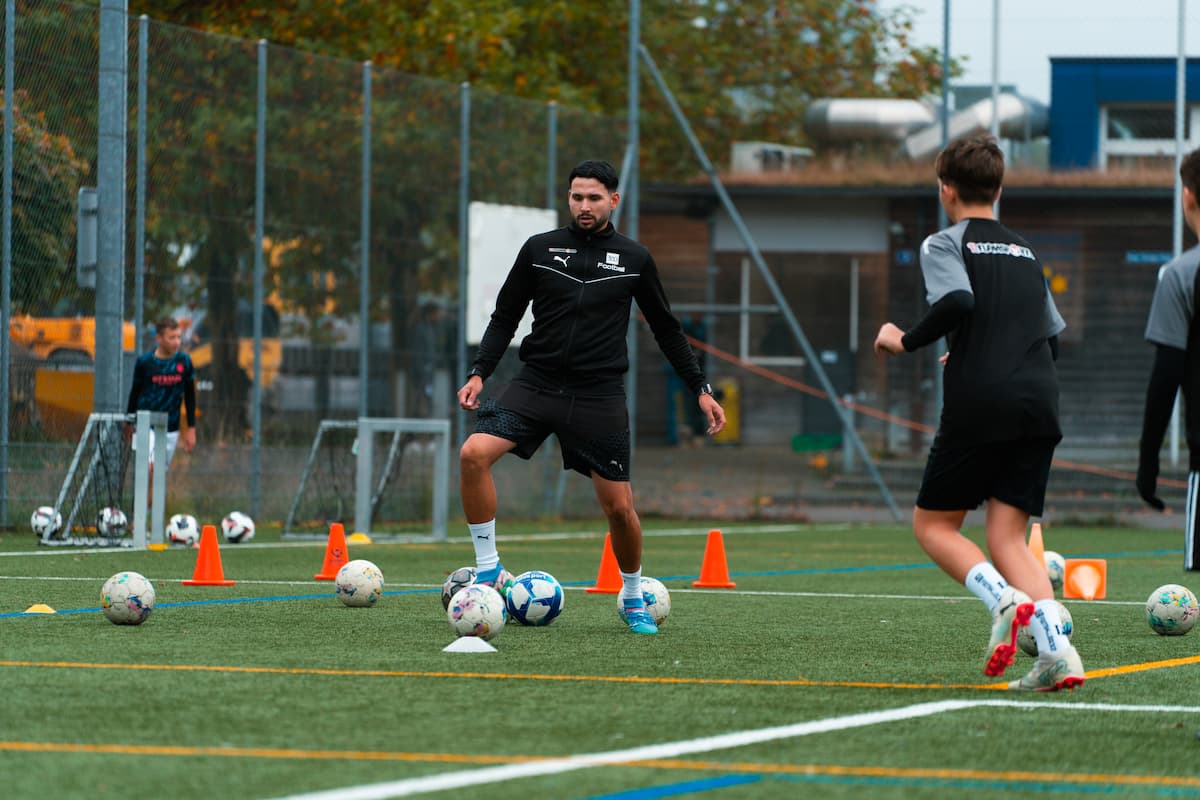The demands placed on the position of the winger have changed enormously in recent decades. In the past, the tasks of the winger when in possession of the ball were almost exclusively reduced to dribbling along the line and playing crosses. In modern football, however, it takes more than speed and precise crosses to be one of the best wingers.
An outstanding outside striker or winger not only provides assists, but also scores goals – be it through an inside shot from the half-space or by converting a cross at the far post.
In addition, the options for solving 1-on-1 situations have also expanded. While previously only a breakthrough towards the baseline was sought, today a targeted dribble inwards is also sought for a follow-up move in the half-field. But tying up opponents with dribbling on the outside has also become more important. Wingers who are good at dribbling draw 2-3 opponents towards them with close and tricky ball control, thereby creating space for their teammates.
With this blog post we want to help you become a more complete and better winger. You will learn how to:
-
offer yourself skillfully at the wing and run free
-
have a solution for every 1-on-1 on the wing
-
become extremely dangerous as a winger
This individual training for wingers will support you on the pitch:
Offering and running free as a winger
In order for you as a winger to be able to use your varied dribbling or precise finishing, you first have to win the ball yourself or receive it from a teammate. There is generally more space on the flanks, as in modern football the focus when playing against the ball is very much on securing the middle of the field. You can use this space on the wings excellently for dribbling past your opponents.
You have the best conditions to dribble past your opponent if you can act openly in the direction of play and have already picked up speed. On the other hand, if you are standing with your back to the direction of play and your opponent is directly behind you, you have worse conditions to win a 1-on-1. Your goal as a winger must therefore be to offer yourself cleverly in order to be able to turn and, ideally, to gain some distance from your opponent.
Running feints: going and coming
Running feints can help you offer yourself effectively:
-
Fake a run downwards with a few steps or a lunge.
-
Your opponent will usually move backwards to secure the space behind him.
-
Shortly before the pass, you explosively change direction and move diagonally backwards and outwards.
This change of direction gives you valuable space that you can use with the first contact forward.
Running feints: coming and going
If your opponent is particularly close to you, this technique will help you:
-
Indicate a movement towards the teammate with the ball with a few steps or a lunge.
-
The defender follows you at a short distance.
-
Use the moment just before the pass for an explosive attack into the depth.
This approach allows you to be played behind the defender while he reacts to your previous movement.
In order for your running feints to be effective, you need to be able to make explosive, sharp changes of direction. These exercises can help you with that.
The open position
Due to the focus on the middle of the field in modern defending, as a winger you often don't have an opponent directly at you if you use the width of the field. Especially after the game has shifted, you often have enough time for a clean first contact.
Advantages of the open position
-
Time saving: You can take the ball directly in the direction of play without an unnecessary intermediate step.
-
Better overview: The depth remains in view, allowing you to react to situations more quickly.
Never stand with your back to the opponent's goal, but use the distance to your opponent (even if it is only 3-4 meters) to offer yourself in an open position. This way you can process the ball directly or pick up speed.
The 1-on-1 on the wing
starting position for a successful 1-on-1
If you have put yourself in a favorable position through an open position or a running feint, you have several options for 1-on-1:
-
Diagonal forward: Take the ball diagonally forward and inward towards your opponent with the first contact.
-
Dribbling along the line: Rarely recommended as the touchline limits you and makes it easier for the opponent to defend.
dribbling tactics
-
Force Backward Movement: Dribble diagonally at the defender to force him to move back while securing the center.
-
Observe the game: Notice whether an additional opponent, such as a six, comes to support the defender and adjust your dribbling direction.
Regardless of the direction, tricks like body feints or stepovers will help you disrupt your opponent's balance.
The goal finish as a winger
Modern wingers are not only provider of assists, but also goal scorers. In addition to precise finishing, the running-in behavior for crosses also plays a key role.
running-in behavior of flanks
-
Run to the far post: Use every cross to create a threat in the box. The opponent will often be distracted by watching the ball, giving you the opportunity to get behind him.
-
Second ball: Often a cross that is not used immediately will end up as a rebound near you. Be prepared for this.
finishes from the half-space
-
Inside instep shot: Shot precisely into the far corner, difficult for the goalkeeper to save.
-
Full-Bow Shot: Surprise the goalkeeper with a powerful shot into the near corner.
-
Spin: Hit the ball from the outside to curve it around opponents or the goalkeeper.
If the angle is too sharp, a powerful full-strike under the bar can be the most effective option. Here are a few simple exercises:
If you are looking for a whole training session for wingers alone, you can find it here:
Conclusion
A modern winger needs to be versatile and excel as both an assist provider and a goalscorer. With a combination of tactical understanding, technical skills and clever running-in behaviour, you can take your game to the next level.
For more tips and on-site football personal training , check out our other content.
#LevelUpYourGame
-
Train with a structured training plan for footballers
-
Book a football personal training session and improve more than just your speed.
-
Take your diet to the next level. With tips on regeneration and nutrition and our Supplements for footballers .
About the author:
Luis Österlein (Twitter: LOsterlein ) is a match analyst for FC Bayern Munich's U23 team and a freelance author. In close collaboration with 360Football, he writes specific blog posts to support players in their football development.
Non-binding registration for an initial consultation (100% free) with 360Football for football performance optimization.
For a free initial consultation, as well as for individual inquiries about individual training, goalie training, training programs, nutritional advice, video, game analysis or mental and athletic training , use the form below.


